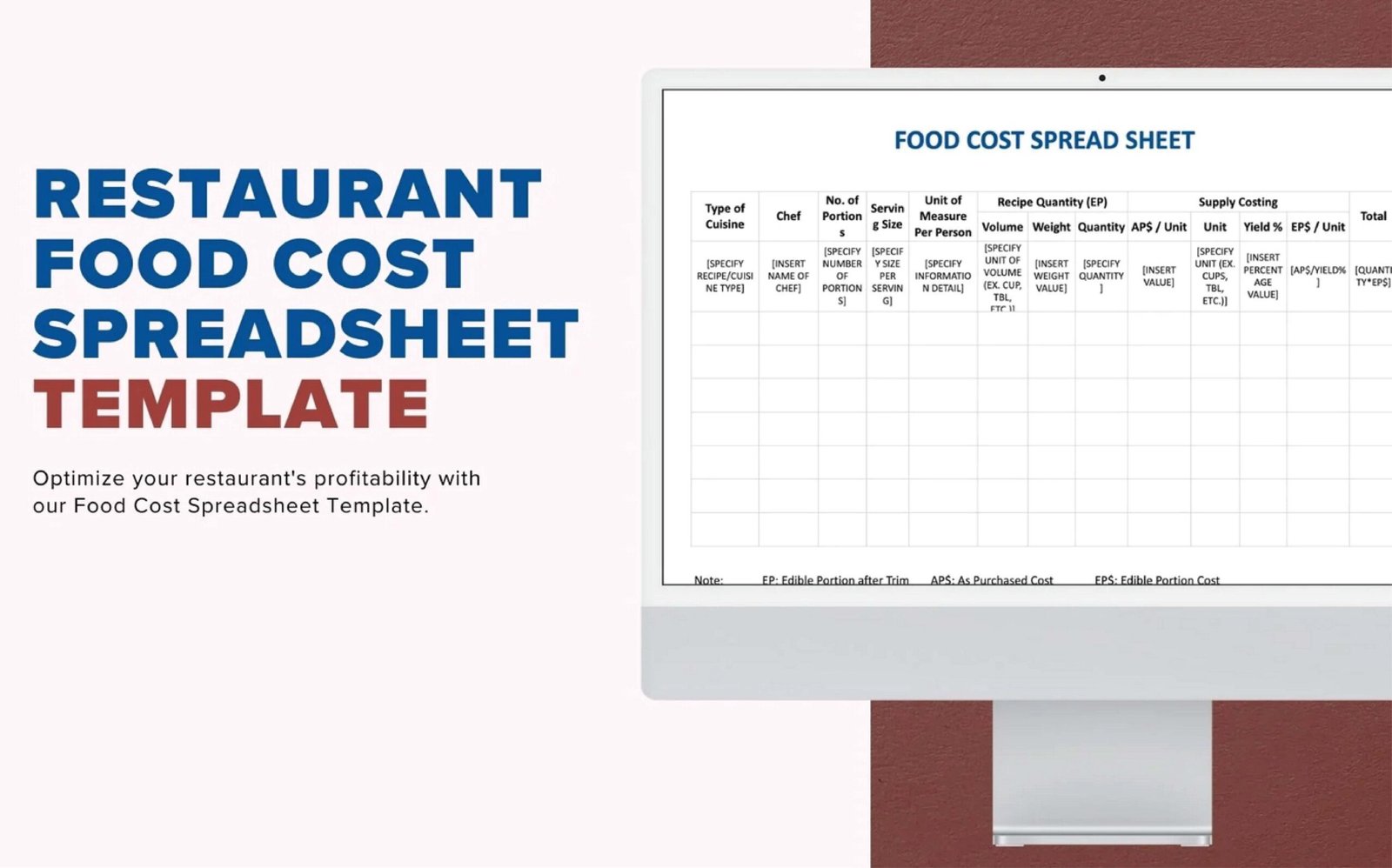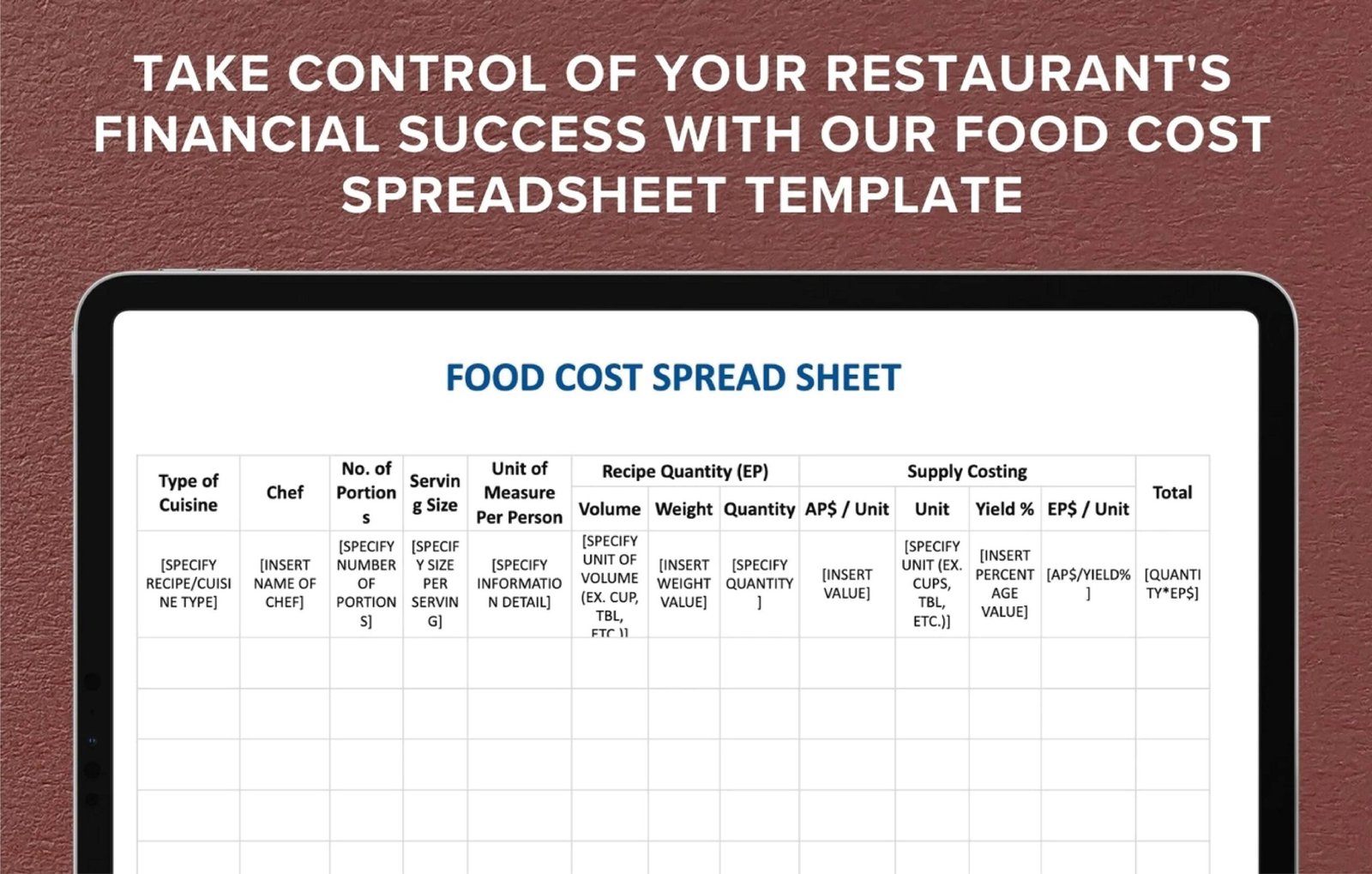Food cost refers to the total amount spent on food and beverages. This includes the cost of raw ingredients, packaging, transportation, and storage. In project management, tracking food costs is crucial to maintain profitability and control expenses. This spreadsheet allows businesses to record and analyze their food-related expenses, helping them make informed decisions.

Importance of Food Cost Management:
Effective food cost management ensures that businesses do not overspend and can maintain a healthy profit margin. It helps in:
- Budgeting: Accurate food cost tracking enables businesses to create realistic budgets and stick to them.
- Pricing: Knowing the exact food costs allows businesses to price their menu items appropriately.
- Profitability: Controlling food costs directly impacts the profitability of a business.
- Waste Reduction: By monitoring food usage and costs, businesses can reduce waste and improve efficiency.
Related Article: Kanban Project Management Tools
Identifying the Components:
This spreadsheet typically includes several key components that help in detailed tracking and analysis. These components include:
Ingredient List
The ingredient list is a comprehensive inventory of all ingredients used in preparing menu items. Each ingredient’s cost is recorded to calculate the total cost of a dish.
Purchase Records
Purchase records track all purchases made for ingredients and other food-related items. This helps in monitoring expenses and ensuring that all costs are accounted for.
Recipe Costing
Recipe costing involves calculating the cost of each menu item based on the ingredients used. This helps in setting the right prices for menu items and ensuring profitability.
Sales Data
Sales data includes information on the quantity of each menu item sold. This helps in analyzing the profitability of each item and identifying popular dishes.
Related Article: Project Status Report Template
Inventory Management
Inventory management tracks the stock levels of ingredients. It helps in ensuring that there is always enough stock to meet demand without overstocking, which can lead to waste.
Waste Tracking
Waste tracking records any food that is discarded. This helps in identifying areas where waste can be reduced and improving overall efficiency.
Defining the Key Benefits:
<p>A food cost spreadsheet offers numerous benefits to businesses in the food industry. These benefits include:
Accurate Cost Tracking
This spreadsheet provides accurate and detailed tracking of all food-related expenses. This helps in understanding the true cost of each menu item and making informed decisions.
Improved Profitability
By accurately tracking food costs and pricing menu items appropriately, businesses can improve their profitability. The spreadsheet helps in identifying high-cost items and finding ways to reduce expenses.
Enhanced Budgeting
This spreadsheet enables businesses to create accurate budgets and stick to them. This helps in controlling expenses and ensuring financial stability.
Related Article: Project Resource Planning Template
Waste Reduction
Tracking food costs and usage helps in identifying areas where waste can be reduced. This improves efficiency and reduces unnecessary expenses.
Better Inventory Management
Also, the spreadsheet helps in maintaining optimal inventory levels. This ensures that there is always enough stock to meet demand without overstocking.

Creating a Food Cost Spreadsheet:
Here is a step-by-step guide to creating an effective spreadsheet:
Step 1: List Ingredients
Start by listing all the ingredients used in your menu items. Include the cost of each ingredient and the quantity used in each recipe.
Step 2: Record Purchases
Record all purchases of ingredients and other food-related items. Include the date of purchase, supplier, and cost.
Step 3: Calculate Recipe Costs
Calculate the cost of each menu item by adding up the cost of all ingredients used. This helps in setting the right prices for your menu items.
Step 4: Track Sales
Record the quantity of each menu item sold. This helps in analyzing the profitability of each item and identifying popular dishes.
Step 5: Monitor Inventory
Track the stock levels of ingredients to ensure that you always have enough to meet demand. This helps in reducing waste and improving efficiency.
Step 6: Analyze Waste
Record any food that is discarded and analyze the reasons for waste. This helps in identifying areas where waste can be reduced.
Related Article: Business Roadmap Templates
Using in Project Management:
In project management, food cost spreadsheets play a vital role in ensuring the success of food-related projects. They help in:
Planning
Food cost spreadsheets provide detailed information on costs, helping in planning projects effectively. This ensures that all expenses are accounted for and that the project stays within budget.
Monitoring
By tracking food costs and usage, food cost spreadsheets help in monitoring the progress of a project. This ensures that any issues are identified and addressed promptly.
Reporting
Food cost spreadsheets provide detailed reports on expenses and profitability. This helps in evaluating the success of a project and making informed decisions.
Decision Making
Accurate food cost data helps in making informed decisions regarding pricing, budgeting, and resource allocation. This ensures that projects are profitable and successful.
Related Article: Construction Project Management
Challenges in Managing Food Costs:
Managing food costs can be challenging due to several factors. These challenges include:
Price Fluctuations
The cost of ingredients can fluctuate due to various factors, making it difficult to maintain accurate cost tracking.
Waste Management
Reducing food waste is crucial for controlling costs, but it can be challenging to identify and address areas where waste occurs.
Inventory Management
Maintaining optimal inventory levels is essential for reducing waste and controlling costs. However, it can be challenging to balance stock levels with demand.
Data Accuracy
Accurate data is crucial for effective food cost management. Ensuring that all data is recorded correctly and consistently can be challenging.
Also Checkout: Project Management Bundles
Tips for Effective Food Cost Management:
To effectively manage food costs, consider the following tips:
Monitor Costs Regularly
Regularly monitor food costs and update your food cost spreadsheet to ensure accurate and up-to-date information.
Analyze Sales Data
Analyze sales data to identify popular and high-cost items. This helps in making informed decisions regarding pricing and menu planning.
Reduce Waste
Identify areas where waste occurs and find ways to reduce it. This can include better inventory management and more efficient use of ingredients.
Negotiate with Suppliers
Negotiate with suppliers to get the best prices for ingredients. This can help in reducing costs and improving profitability.
Use Technology
Use technology to streamline the process of tracking and managing food costs. This can include using software to automate data entry and analysis.
Related Article: Expense Management – Wikipedia
Conclusion:
Food Cost Spreadsheet is an essential tool for businesses in the food industry. It helps in accurately tracking food costs, improving profitability, and ensuring the success of food-related projects. By understanding the components and benefits of this spreadsheet, and following best practices for creating and using them, businesses can effectively manage their food costs and achieve their financial goals.
Managing food costs requires careful planning, regular monitoring, and effective decision-making. With a well-designed spreadsheet, businesses can achieve greater efficiency, reduce waste, and improve their bottom line. Whether you are running a restaurant, catering service, or any other food-related business, food cost spreadsheets will provide the insights and control needed to succeed in a competitive industry.


